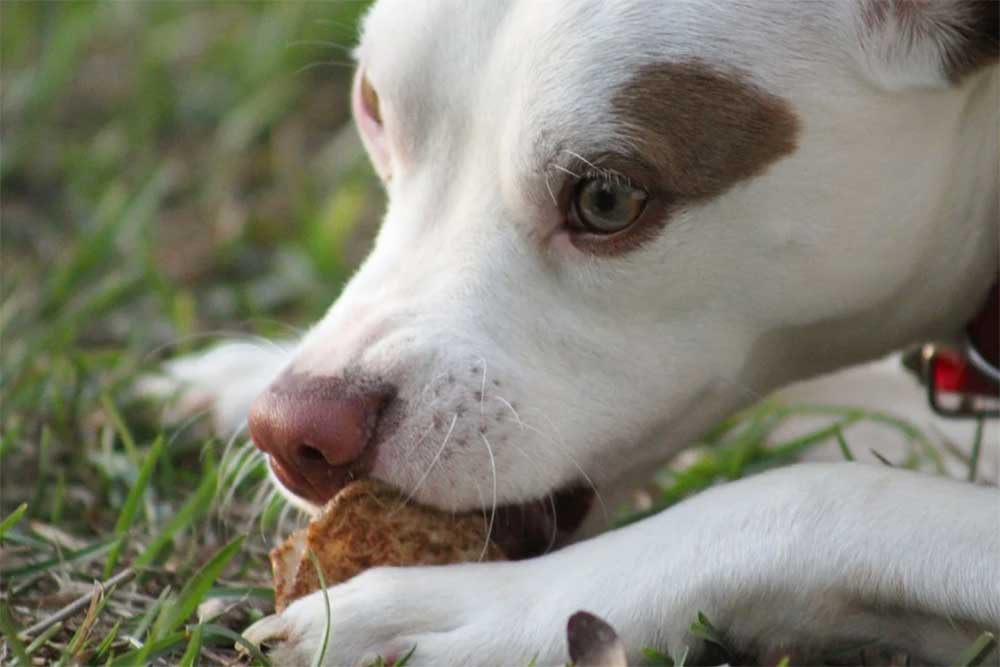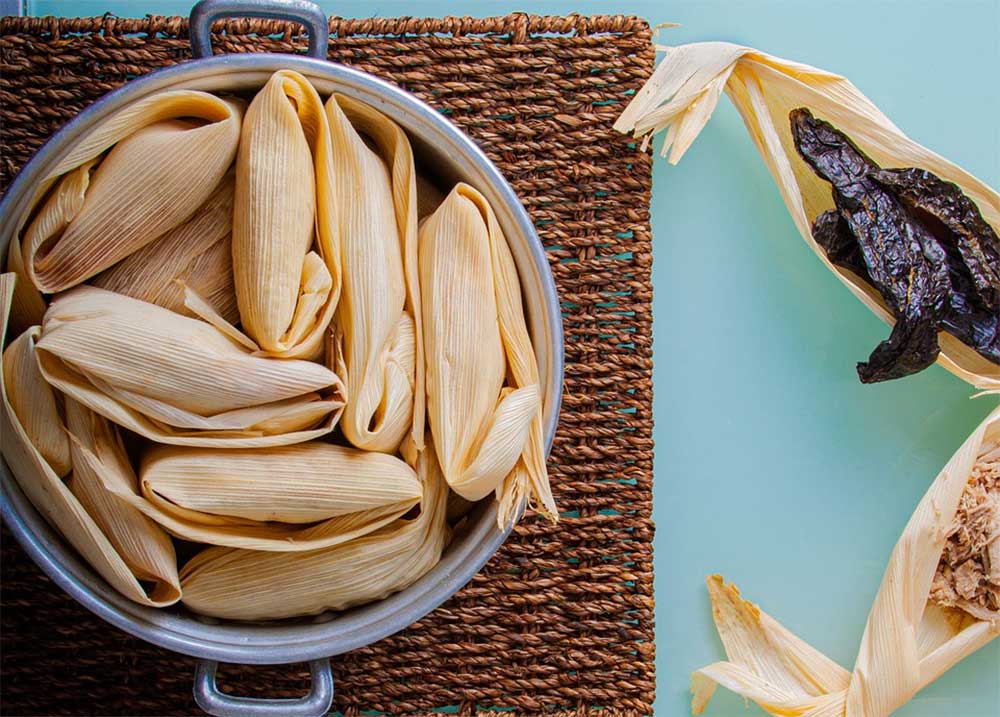Tamales are a popular dish in Mexico, Latin America, and the United States. If you have a dog in the home, you know how quickly they can gobble up food from the ground. You may have dropped a tamale on the floor and before you knew it, it had disappeared. If you suspect that your dog has eaten a tamale, it is often worth taking them to a veterinarian for a health check.
Tamales are believed to have been eaten as far back as 8000 – 5000 BC in Mesoamerica. They are thought to have originated from Mexico’s indigenous culture and have been referenced in the Mural of San Bartolo in Guatemala. Ancient Aztec and Mayan cultures ate tamales as they were easily portable and had a good level of nutrient density. One of the main deities in the Mayan religion is the Maize God.
Corn has long been spiritually significant in this area of the world. The Maize God is closely associated with the cycle of rebirth, the seasons, and even the human life experience. They are eaten year-round, although they are a significant food during festive periods such as Christmas, Day of the Dead, and Candlemas.

Tamales are a corn dough known as masa which is enriched with lard and beaten to incorporate air. When the masa is fluffy, it is spread out over a soaked corn husk or plantain leaf. It is then topped with a filling made of meat.
Traditionally, the meat is chicken, beef, steak, or pork. The meat is mixed with pine nuts, cheese, poblano, and salsa. The tamales are wrapped so that the masa encloses the filling. The corn husks are then tightly wrapped, tied closed, and steamed.
The filling can vary greatly depending on the area and traditional recipes of each family. You can add seasonings and even make sweet versions of tamales. Every tamale must have a masa shell and will be wrapped in a corn husk or plantain leaf. Many modern tamale recipes incorporate baking powder to help the dough rise.
Can dogs eat corn husks?
Generally speaking, it is best to avoid feeding your dog corn husks. They are not toxic to your dog, but they can pose them considerable danger. The corn husks are very tough and fibrous. This means that they can be a choking hazard for your dog as they try to swallow.
As well as this, the high fiber content means that the corn husk is indigestible for your dog. It can cause digestive obstructions which, if left untreated, can cause serious health issues. Some symptoms of gastrointestinal blockage to keep an eye out for include vomiting, difficulty passing stool, and a loss of appetite. If you suspect they have abdominal pain or they appear particularly restless, it is worth taking them to the vet.
If your dog has only eaten a small portion of corn husk, they are likely to be uncomfortable but they are not in much real danger. They will likely have some gas, but anything more serious and we recommend taking them to a qualified veterinarian.
Can dogs eat the inside of tamales?
This is dependent on what you have filled your tamale with. If it is simply meat and vegetables this is often safe for your dog to consume. Ensure that the filling has no onion or garlic inside though. These foods belong to the allium family, along with leeks and chives.
All of these plants are toxic to dogs and cause serious illness if eaten. Onions can kill off the red blood cells in your dog’s body, which can lead to them becoming anemic. As little as one medium onion can be dangerously toxic to a 45-pound dog, and this decreases as the dog’s weight drops.
Tamales are made with the human palette in mind, meaning that they are often heavily seasoned. Tamales usually have quite a high sodium content due to the salt added as a flavor enhancer. In smaller quantities, this is likely to just cause your dog to be more thirsty than usual.
In extreme cases, this could lead to an illness known as sodium ion poisoning. Their body will release water to counteract the high salt levels in the blood. This draws water away from the brain and the cells there begin to die. Symptoms include dizziness and seizures. If left untreated, this can be fatal for dogs.
Many tamales will also contain spices, chili, and other seasonings. Generally speaking, dogs should not be consuming heavily seasoned foods. Chilli spice is particularly bad for them and can be toxic.
Tamale fillings are often fairly high in protein which will not cause your dog any health issues. If the filling contains a lot of vegetables they likely are high in fiber. This will help with your dog’s digestion and is an important part of a healthy diet.
High calorie counts can be detrimental to their health
While the component ingredients (aside from the ones mentioned above) are mostly safe for dogs to eat, this does not mean that they should. The masa in most tamales has been enriched with lard. This is a form of fat that has been rendered down from pig fat. The filling of the tamale is also likely to contain other saturated fats in the form of cheese.
A diet that is higher in fat can be useful if your dog is underweight or is a working dog, but in most cases, it is not necessary. Too much fat in your dog’s diet can cause them to gain weight and can lead to the development of pancreatitis, heart problems, and cardiovascular disease.
There are no specific calorie requirements for dogs published anywhere. The amount your dog needs will be individual to them and depends on a variety of factors. Your dog’s weight and activity level are the two most important considerations, although their age, gender, and whether they have been neutered also have an impact. There are many websites such as this one where you can work out your dog’s approximate daily calorie requirement.
As a general rule, experts recommend 25 calories per pound of body weight daily. Three popular dog breeds in the United States are labrador retrievers, bulldogs, and Yorkshire terriers. The average weights of each breed are listed below.
- Labrador retriever – 55 – 79 lbs
- Bulldog – 18 – 39 lbs
- Yorkshire terrier – 4 – 7 lbs
From the weights given above, we can work out the approximate caloric needs of each breed. A labrador retriever will need 1,375 – 1,975 calories each day. A bulldogis will need 450 – 975 calories per day, and a Yorkshire terrier will only need 100 – 175 calories daily. This shows the enormous discrepancy in the nutritional requirements of each breed.
An average tamale contains between 200 and 280 calories. If you fed this to a larger breed of dog, it would likely have little impact as they have a high caloric demand. Feeding an entire tamale to a small breed would easily be above their daily calorie requirement. This could cause health issues over time, such as obesity and any associated comorbidities.
The general feeding rule for dogs is 90/10 of healthy food to snacks. As we have mentioned, tamales are definitely not a healthy food source. This means that were you to feed your dog tamales, they should only make up 10% of their daily calories. Even for a larger dog like a labrador retriever, an entire tamale would exceed this 10% limit.
Can I make dog-friendly tamales?

There are many ways in which you can make tamales that are safe and even healthy for your dog to eat. There is no reason that they should miss out on all of the tamale fun!
An easy way to make the filling healthier for your dog is to replace the pork meat with leaner protein sources such as shredded chicken, turkey, or shrimp. You can use beans and vegetables to bulk out the filling. These will also add some extra healthy fiber, vitamins, and minerals to the tamale. Good vegetables to include are kale, spinach, carrots, green beans, broccoli, beetroot, celery, butternut squash, and sweet potatoes.
Instead of using lard to enrich the masa dough, you can substitute low-fat soft cheese. This will greatly reduce the saturated fat content, making the dough much healthier for your dog to consume. Do not use the cream cheese in excess, as it is still not a healthy food choice overall. You should ensure that your dog is not lactose intolerant prior to making this substitution.
When making tamales for dogs, there is no need to add any additional salt or seasonings. Dogs have a much more sensitive palate than humans do, and will be able to enjoy the raw flavors without the need for an enhancing agent.
Making them like this will also be much better for your dog’s health. They will not taste as good to you, but your dog will love them. They will be even happier when they realize you’re not going to steal their food.
What should I do if my dog has eaten a tamale?
This depends on the size of your dog, the amount of the tamale they have eaten, and their health before eating it. The best thing to do is to monitor your dog closely for a few hours after they have eaten the tamale.
If they did not eat much of it, then they will probably be sick as their body rejects the incompatible food. This is commonly the case when they eat a tamale still wrapped in the corn husk. They may also experience a bout of diarrhea due to the gastrointestinal distress.
If you suspect they have eaten an entire tamale, or you have not seen them vomit, we strongly recommend that you take them to a vet. The vet will be able to perform a physical examination of your dog and will be able to carry out further medical procedures to ensure your dog is not in danger. They will be able to give you further and more detailed advice on the aftercare process.
Warning signs to look out for include your dog moving abnormally or appearing to be in pain, especially in the abdominal region. If they are consistently vomiting they will not be able to keep food or water down. This can lead to them becoming dangerously dehydrated or malnourished.
A similar concern is if they stop eating and/or drinking. Your dog suddenly becoming restless and reluctant to settle is often another indication that something is wrong that needs medical attention.
What about candy tamales?
We cannot talk about tamales without mentioning the candy version, Hot Tamales. Dogs should not be eating sweets in the first place, and these are no exception.
Sugar is not good for dogs, although if they occasionally snaffle a candy from the ground they will be okay. Sugar is not toxic to dogs, but can cause obesity and other health issues if eaten consistently and in high quantities. Even a small amount of sugar being incorporated into your dog’s regular diet can cause dental issues, metabolic damage, and an increased risk of developing canine diabetes.
Hot Tamales contain a number of artificial colorings and flavorings. They also have a number of other synthetic ingredients. Your dog’s stomach is much more sensitive than a humans, as they have not become accustomed to the unnatural ingredients in a lot of candy. This means that while the occasional candy is unlikely to cause more than an upset stomach, it is not something that should be fed to your dog deliberately.
Hot Tamales, as the name suggests, are also spicy. We have mentioned above the potential harmful impacts of spicy foods upon the digestive system of dogs. All in all, it is probably best to keep the candy for yourself. It will be appreciated more that way.
